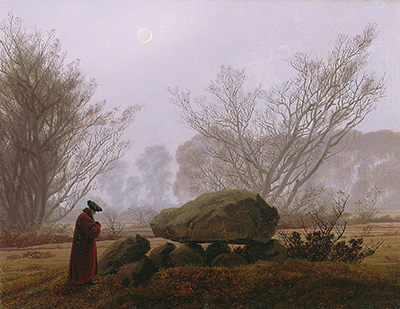Caspar David Friedrich remains a top name in the history of German Romanticism art and his works based on allegorical landscapes in portraying figures that were often seen with their backs facing the viewer have made a lot of art lovers contemplate on the expanse of nature and the effect of the dusky skies in his art pieces.
Caspar created this masterpiece around 1830 or thereabout. In the foreground, you could vividly see a man walking with his back turned against the viewer with his head bowed down with a moonlit background in a seemingly chilly surrounding. You can also see a megalithic tomb that depicts death with everything around the subject of the portrait seemingly dying. The leafless trees in the background seem shadowy but the oaks rise through the mist, which is an expression of the promise of life. This was one among the few paintings that Casper did before suffering from a debilitating stroke. The painting was a depiction of the melancholy the artist was going through during the period but the oaks indicate the promise of life he found Christian faith.
The painting is a clear testament to Caspar’s love for the use of the crescent moon as a resonant and complex symbol for Christ. He used his magnificent brushworks to portray the illumination of the sun as an expression of the G0d-like source of life. The contrasting brushworks played a crucial role in depicting the light from the moon that cast out the darkness that is symbolism of the approaching night of death. He was able to achieve all this by preparing his canvas then elaborated the surface with ink sketches and finally painted over the sketches with oiled luminous glazes. This technique helped him in achieving the element of atmospheric space and making the mist to seem like it is slowly unfolding towards the viewer’s eyes. Even though the painting seemed modest, it arouses a monumental feel.
Caspar was not your ordinary artist. When most other great names in the art industry derived inspiration from other great artists, Caspar only took less from the masters that came before him but chose to be inspired by his teachers in formal education. They inspired him to grow closer to nature and be able to see the doing of God in nature. His teachers were mostly teaching Danish Neoclassicism but to Caspar, they instilled approaches from early Romanticism. One of these teachers was Ludwig Gotthard Kosegarten. Other notable names include Jens Juel, Carl Gustav Carus and Philipp Otto Runge. He was also a source of inspiration to several other artists like Anselm Kiefer, Fredric Edwin Church and Gustave Courbet. He also touched some artistic movements in his wake including Abstract Expressionism and German Romanticism.




